Report on the Australian Agriculture Industry: Issues and Policies
VerifiedAdded on 2022/10/17
|16
|3792
|7
Report
AI Summary
This report provides a comprehensive analysis of the Australian agriculture industry. It begins with an overview of the industry's contribution to the Gross Domestic Product (GDP) and its significant role in exports, highlighting key products like wheat, beef, and wool. The report delves into the market structure, characterizing it as monopolistically competitive, and addresses the impact of the 2018-2019 drought, which significantly reduced production and exports. It further explores various challenges, including falling yields, climate change, water scarcity, and biological threats. The report also discusses long-term issues such as political distrust and the debate over genetic modification. Finally, it suggests policy recommendations aimed at improving the industry's condition and contributing to the overall economy. The report emphasizes the industry's importance as a major employer and revenue generator for Australia.
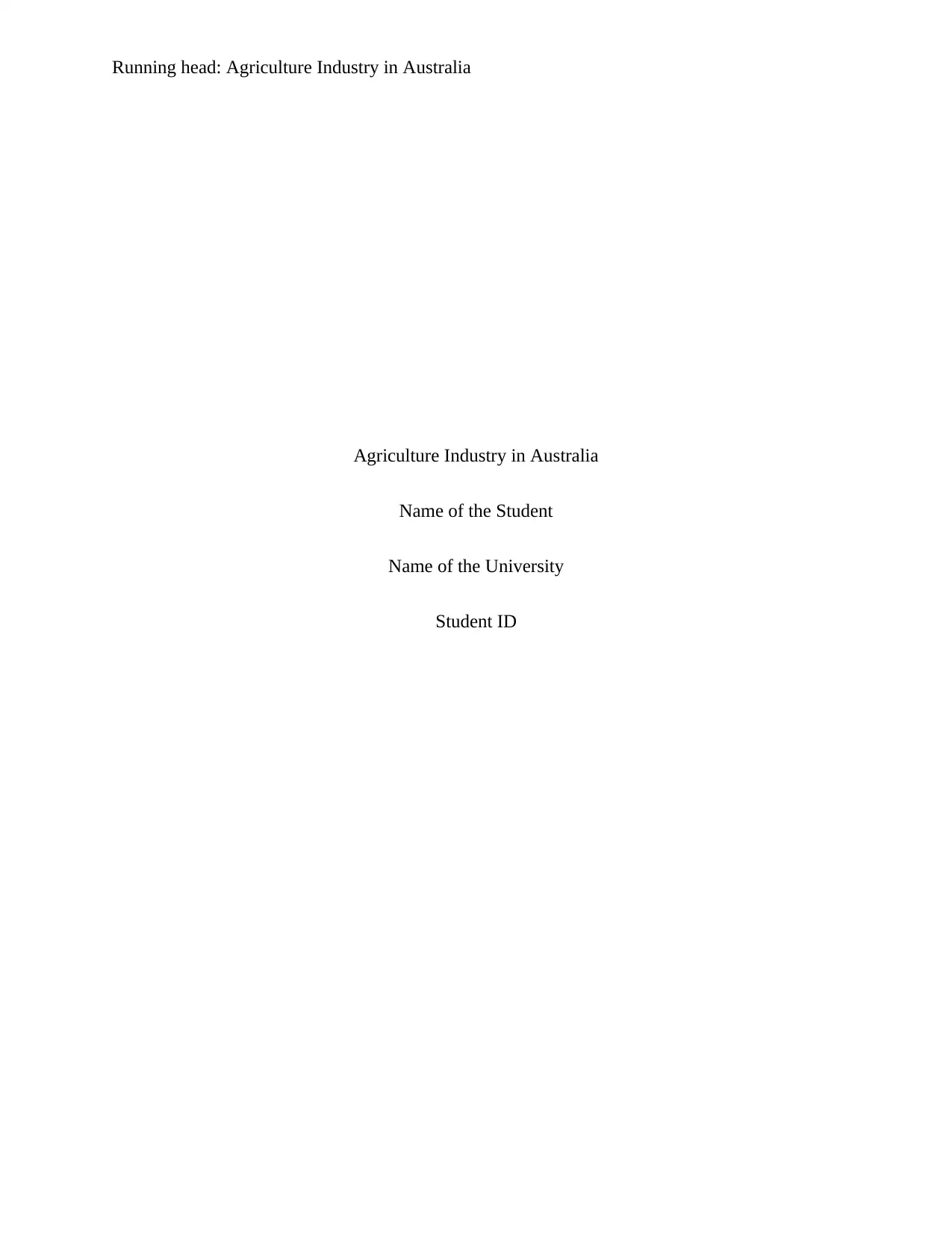
Running head: Agriculture Industry in Australia
Agriculture Industry in Australia
Name of the Student
Name of the University
Student ID
Agriculture Industry in Australia
Name of the Student
Name of the University
Student ID
Paraphrase This Document
Need a fresh take? Get an instant paraphrase of this document with our AI Paraphraser
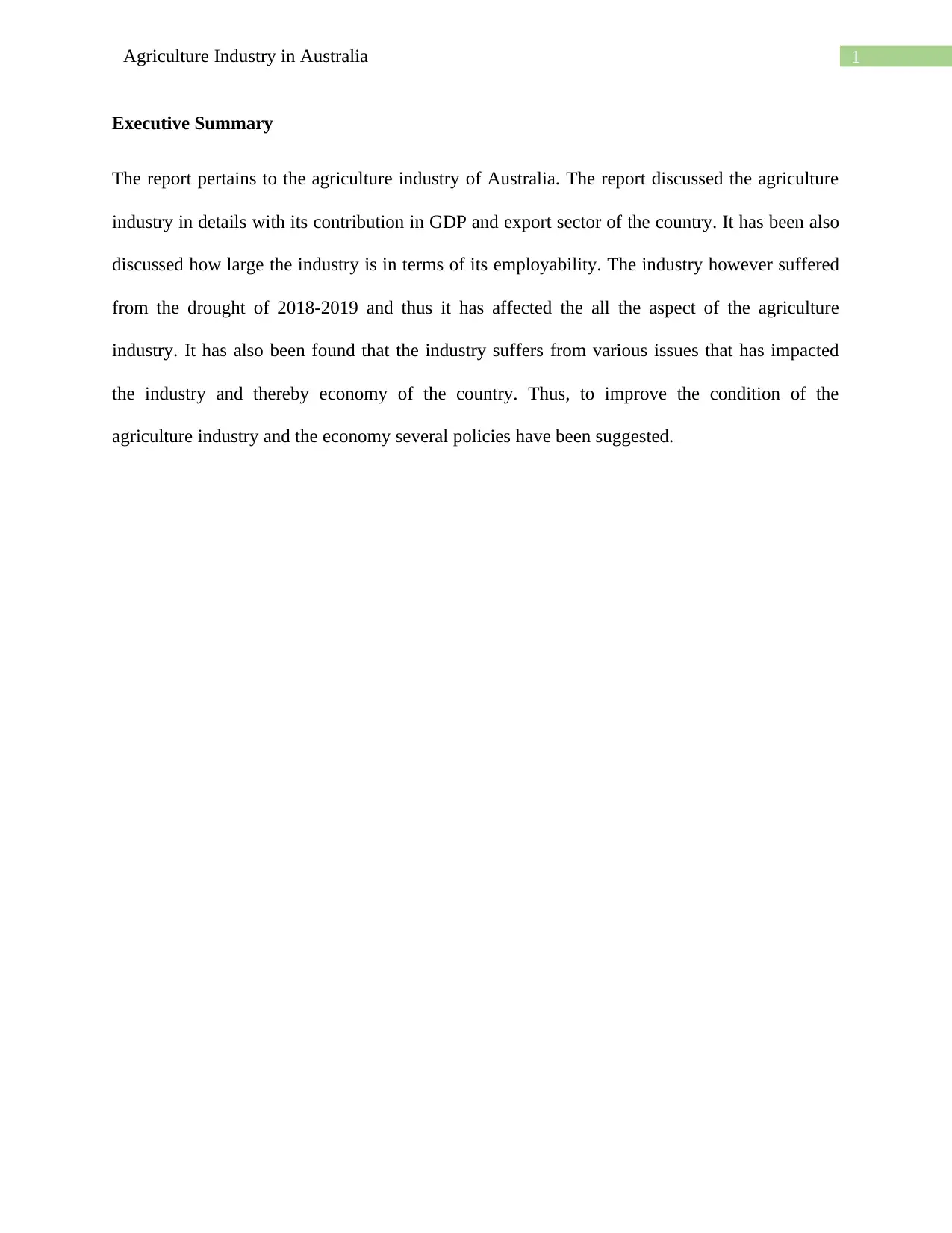
1Agriculture Industry in Australia
Executive Summary
The report pertains to the agriculture industry of Australia. The report discussed the agriculture
industry in details with its contribution in GDP and export sector of the country. It has been also
discussed how large the industry is in terms of its employability. The industry however suffered
from the drought of 2018-2019 and thus it has affected the all the aspect of the agriculture
industry. It has also been found that the industry suffers from various issues that has impacted
the industry and thereby economy of the country. Thus, to improve the condition of the
agriculture industry and the economy several policies have been suggested.
Executive Summary
The report pertains to the agriculture industry of Australia. The report discussed the agriculture
industry in details with its contribution in GDP and export sector of the country. It has been also
discussed how large the industry is in terms of its employability. The industry however suffered
from the drought of 2018-2019 and thus it has affected the all the aspect of the agriculture
industry. It has also been found that the industry suffers from various issues that has impacted
the industry and thereby economy of the country. Thus, to improve the condition of the
agriculture industry and the economy several policies have been suggested.
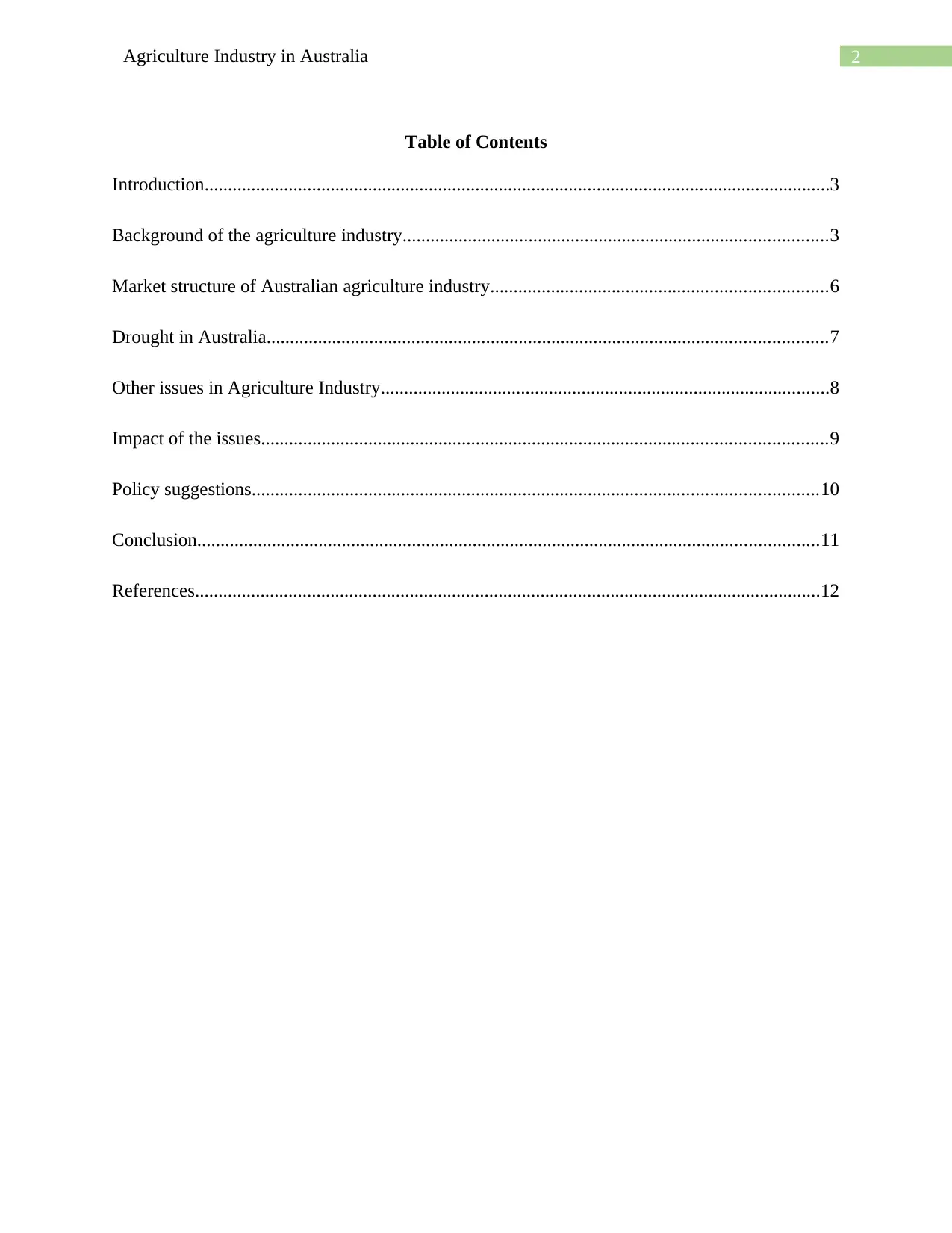
2Agriculture Industry in Australia
Table of Contents
Introduction......................................................................................................................................3
Background of the agriculture industry...........................................................................................3
Market structure of Australian agriculture industry........................................................................6
Drought in Australia........................................................................................................................7
Other issues in Agriculture Industry................................................................................................8
Impact of the issues.........................................................................................................................9
Policy suggestions.........................................................................................................................10
Conclusion.....................................................................................................................................11
References......................................................................................................................................12
Table of Contents
Introduction......................................................................................................................................3
Background of the agriculture industry...........................................................................................3
Market structure of Australian agriculture industry........................................................................6
Drought in Australia........................................................................................................................7
Other issues in Agriculture Industry................................................................................................8
Impact of the issues.........................................................................................................................9
Policy suggestions.........................................................................................................................10
Conclusion.....................................................................................................................................11
References......................................................................................................................................12
⊘ This is a preview!⊘
Do you want full access?
Subscribe today to unlock all pages.

Trusted by 1+ million students worldwide
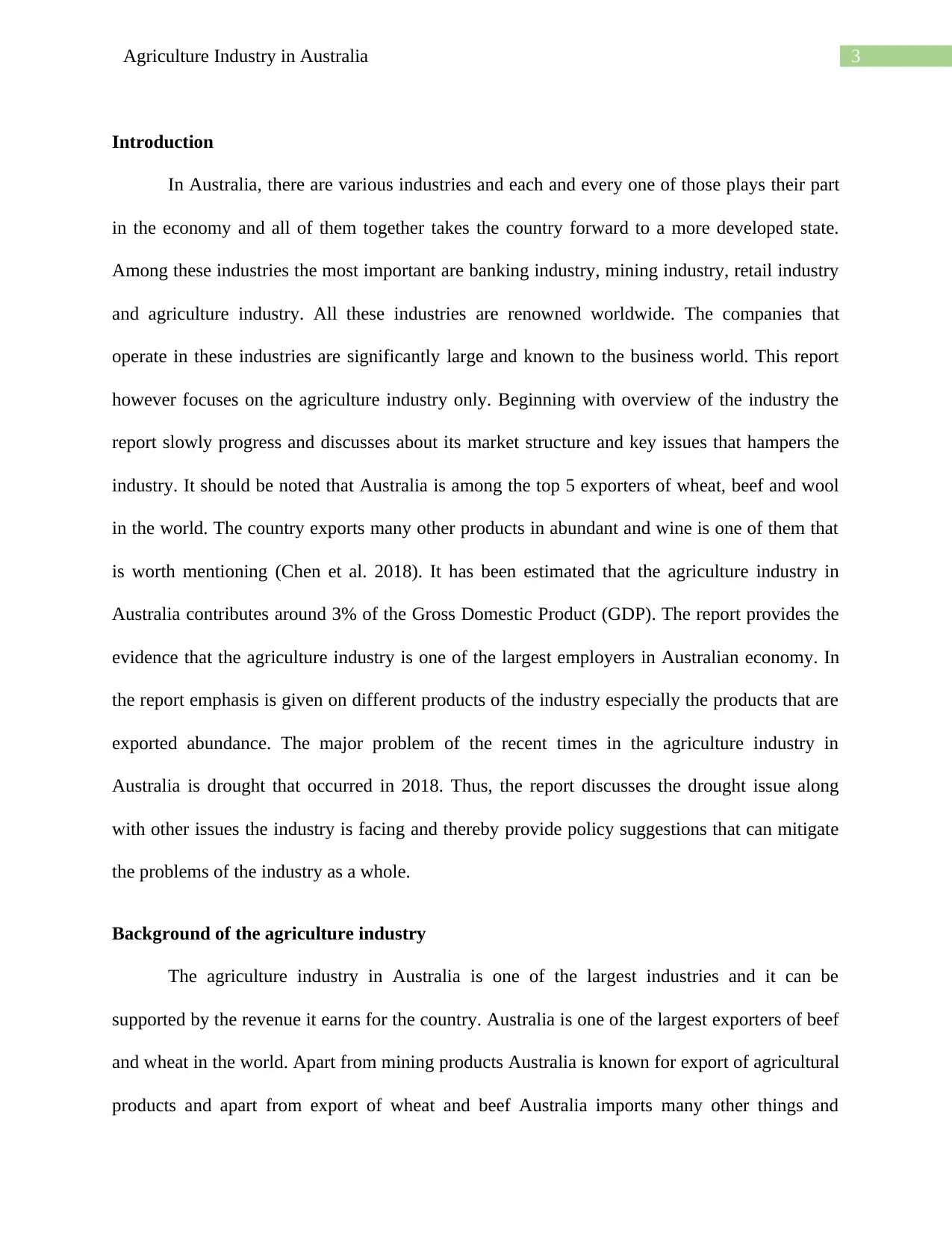
3Agriculture Industry in Australia
Introduction
In Australia, there are various industries and each and every one of those plays their part
in the economy and all of them together takes the country forward to a more developed state.
Among these industries the most important are banking industry, mining industry, retail industry
and agriculture industry. All these industries are renowned worldwide. The companies that
operate in these industries are significantly large and known to the business world. This report
however focuses on the agriculture industry only. Beginning with overview of the industry the
report slowly progress and discusses about its market structure and key issues that hampers the
industry. It should be noted that Australia is among the top 5 exporters of wheat, beef and wool
in the world. The country exports many other products in abundant and wine is one of them that
is worth mentioning (Chen et al. 2018). It has been estimated that the agriculture industry in
Australia contributes around 3% of the Gross Domestic Product (GDP). The report provides the
evidence that the agriculture industry is one of the largest employers in Australian economy. In
the report emphasis is given on different products of the industry especially the products that are
exported abundance. The major problem of the recent times in the agriculture industry in
Australia is drought that occurred in 2018. Thus, the report discusses the drought issue along
with other issues the industry is facing and thereby provide policy suggestions that can mitigate
the problems of the industry as a whole.
Background of the agriculture industry
The agriculture industry in Australia is one of the largest industries and it can be
supported by the revenue it earns for the country. Australia is one of the largest exporters of beef
and wheat in the world. Apart from mining products Australia is known for export of agricultural
products and apart from export of wheat and beef Australia imports many other things and
Introduction
In Australia, there are various industries and each and every one of those plays their part
in the economy and all of them together takes the country forward to a more developed state.
Among these industries the most important are banking industry, mining industry, retail industry
and agriculture industry. All these industries are renowned worldwide. The companies that
operate in these industries are significantly large and known to the business world. This report
however focuses on the agriculture industry only. Beginning with overview of the industry the
report slowly progress and discusses about its market structure and key issues that hampers the
industry. It should be noted that Australia is among the top 5 exporters of wheat, beef and wool
in the world. The country exports many other products in abundant and wine is one of them that
is worth mentioning (Chen et al. 2018). It has been estimated that the agriculture industry in
Australia contributes around 3% of the Gross Domestic Product (GDP). The report provides the
evidence that the agriculture industry is one of the largest employers in Australian economy. In
the report emphasis is given on different products of the industry especially the products that are
exported abundance. The major problem of the recent times in the agriculture industry in
Australia is drought that occurred in 2018. Thus, the report discusses the drought issue along
with other issues the industry is facing and thereby provide policy suggestions that can mitigate
the problems of the industry as a whole.
Background of the agriculture industry
The agriculture industry in Australia is one of the largest industries and it can be
supported by the revenue it earns for the country. Australia is one of the largest exporters of beef
and wheat in the world. Apart from mining products Australia is known for export of agricultural
products and apart from export of wheat and beef Australia imports many other things and
Paraphrase This Document
Need a fresh take? Get an instant paraphrase of this document with our AI Paraphraser
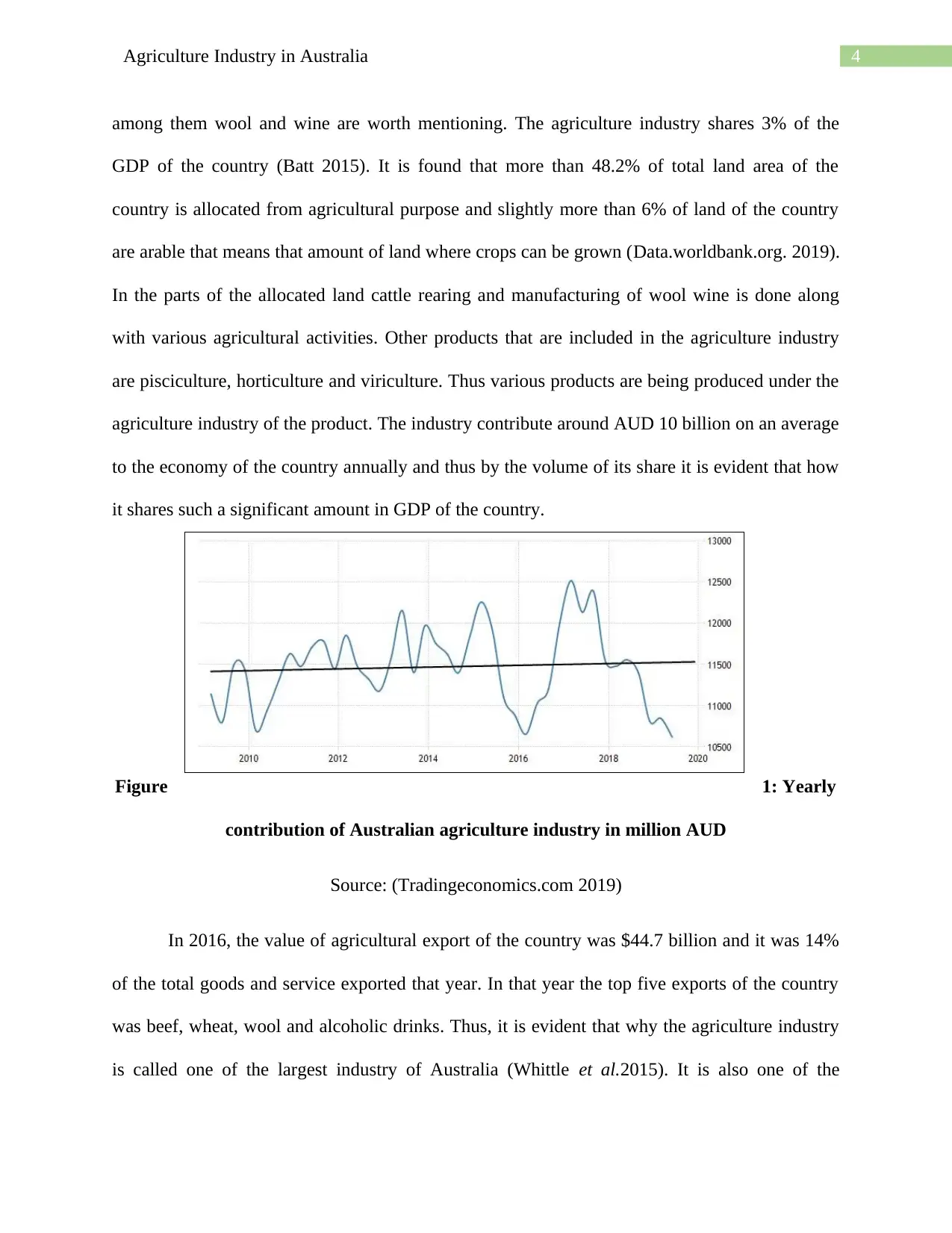
4Agriculture Industry in Australia
among them wool and wine are worth mentioning. The agriculture industry shares 3% of the
GDP of the country (Batt 2015). It is found that more than 48.2% of total land area of the
country is allocated from agricultural purpose and slightly more than 6% of land of the country
are arable that means that amount of land where crops can be grown (Data.worldbank.org. 2019).
In the parts of the allocated land cattle rearing and manufacturing of wool wine is done along
with various agricultural activities. Other products that are included in the agriculture industry
are pisciculture, horticulture and viriculture. Thus various products are being produced under the
agriculture industry of the product. The industry contribute around AUD 10 billion on an average
to the economy of the country annually and thus by the volume of its share it is evident that how
it shares such a significant amount in GDP of the country.
Figure 1: Yearly
contribution of Australian agriculture industry in million AUD
Source: (Tradingeconomics.com 2019)
In 2016, the value of agricultural export of the country was $44.7 billion and it was 14%
of the total goods and service exported that year. In that year the top five exports of the country
was beef, wheat, wool and alcoholic drinks. Thus, it is evident that why the agriculture industry
is called one of the largest industry of Australia (Whittle et al.2015). It is also one of the
among them wool and wine are worth mentioning. The agriculture industry shares 3% of the
GDP of the country (Batt 2015). It is found that more than 48.2% of total land area of the
country is allocated from agricultural purpose and slightly more than 6% of land of the country
are arable that means that amount of land where crops can be grown (Data.worldbank.org. 2019).
In the parts of the allocated land cattle rearing and manufacturing of wool wine is done along
with various agricultural activities. Other products that are included in the agriculture industry
are pisciculture, horticulture and viriculture. Thus various products are being produced under the
agriculture industry of the product. The industry contribute around AUD 10 billion on an average
to the economy of the country annually and thus by the volume of its share it is evident that how
it shares such a significant amount in GDP of the country.
Figure 1: Yearly
contribution of Australian agriculture industry in million AUD
Source: (Tradingeconomics.com 2019)
In 2016, the value of agricultural export of the country was $44.7 billion and it was 14%
of the total goods and service exported that year. In that year the top five exports of the country
was beef, wheat, wool and alcoholic drinks. Thus, it is evident that why the agriculture industry
is called one of the largest industry of Australia (Whittle et al.2015). It is also one of the
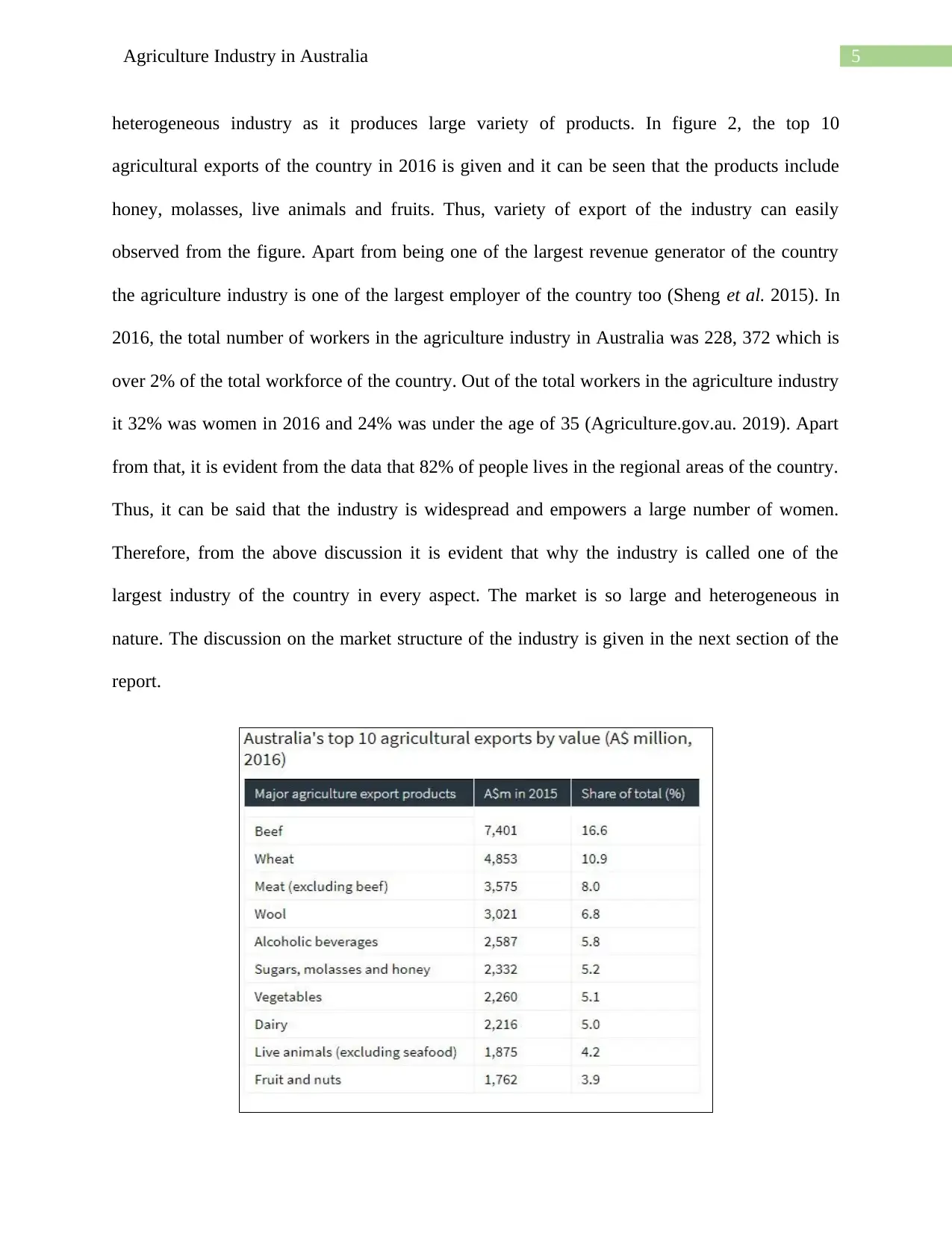
5Agriculture Industry in Australia
heterogeneous industry as it produces large variety of products. In figure 2, the top 10
agricultural exports of the country in 2016 is given and it can be seen that the products include
honey, molasses, live animals and fruits. Thus, variety of export of the industry can easily
observed from the figure. Apart from being one of the largest revenue generator of the country
the agriculture industry is one of the largest employer of the country too (Sheng et al. 2015). In
2016, the total number of workers in the agriculture industry in Australia was 228, 372 which is
over 2% of the total workforce of the country. Out of the total workers in the agriculture industry
it 32% was women in 2016 and 24% was under the age of 35 (Agriculture.gov.au. 2019). Apart
from that, it is evident from the data that 82% of people lives in the regional areas of the country.
Thus, it can be said that the industry is widespread and empowers a large number of women.
Therefore, from the above discussion it is evident that why the industry is called one of the
largest industry of the country in every aspect. The market is so large and heterogeneous in
nature. The discussion on the market structure of the industry is given in the next section of the
report.
heterogeneous industry as it produces large variety of products. In figure 2, the top 10
agricultural exports of the country in 2016 is given and it can be seen that the products include
honey, molasses, live animals and fruits. Thus, variety of export of the industry can easily
observed from the figure. Apart from being one of the largest revenue generator of the country
the agriculture industry is one of the largest employer of the country too (Sheng et al. 2015). In
2016, the total number of workers in the agriculture industry in Australia was 228, 372 which is
over 2% of the total workforce of the country. Out of the total workers in the agriculture industry
it 32% was women in 2016 and 24% was under the age of 35 (Agriculture.gov.au. 2019). Apart
from that, it is evident from the data that 82% of people lives in the regional areas of the country.
Thus, it can be said that the industry is widespread and empowers a large number of women.
Therefore, from the above discussion it is evident that why the industry is called one of the
largest industry of the country in every aspect. The market is so large and heterogeneous in
nature. The discussion on the market structure of the industry is given in the next section of the
report.
⊘ This is a preview!⊘
Do you want full access?
Subscribe today to unlock all pages.

Trusted by 1+ million students worldwide
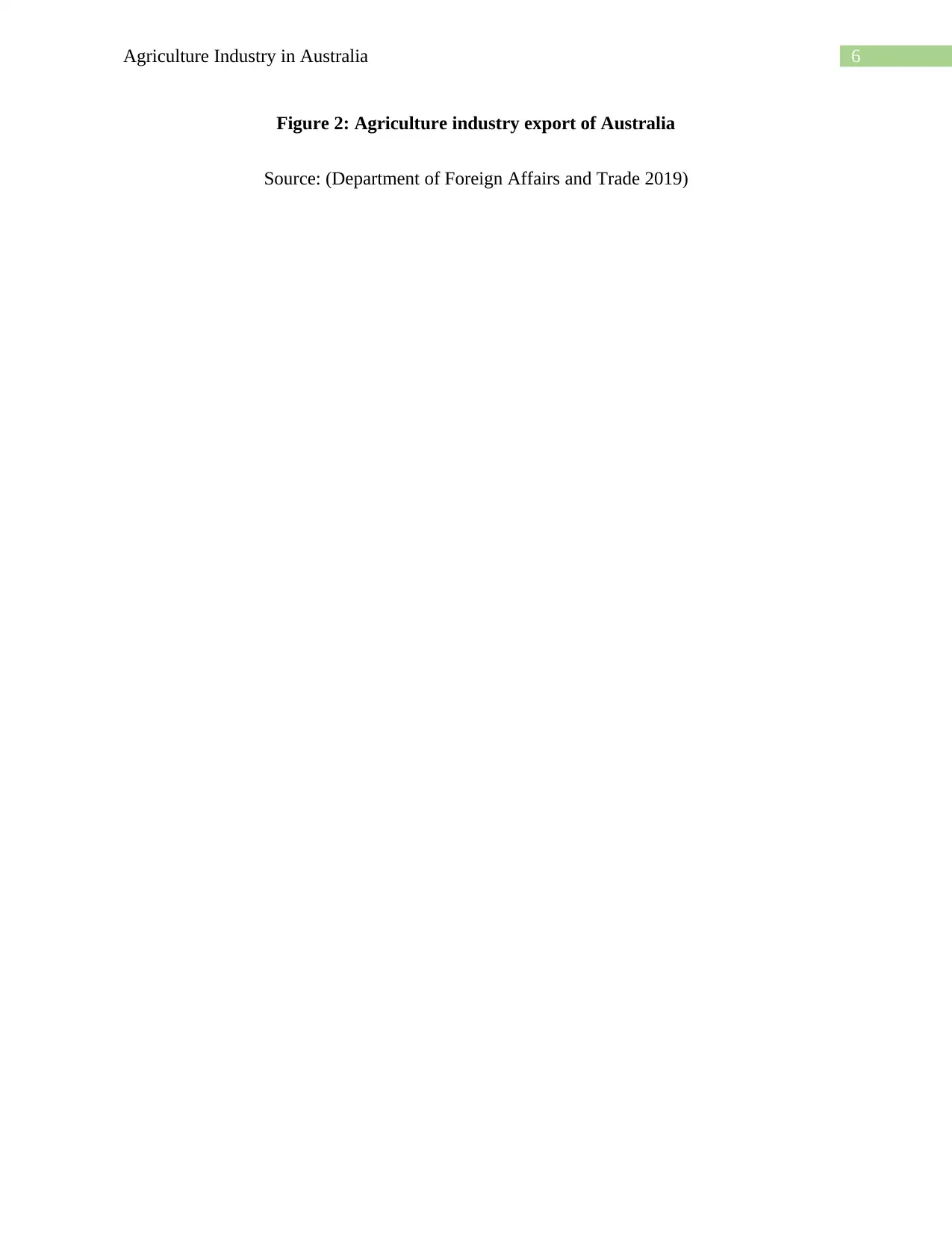
6Agriculture Industry in Australia
Figure 2: Agriculture industry export of Australia
Source: (Department of Foreign Affairs and Trade 2019)
Figure 2: Agriculture industry export of Australia
Source: (Department of Foreign Affairs and Trade 2019)
Paraphrase This Document
Need a fresh take? Get an instant paraphrase of this document with our AI Paraphraser
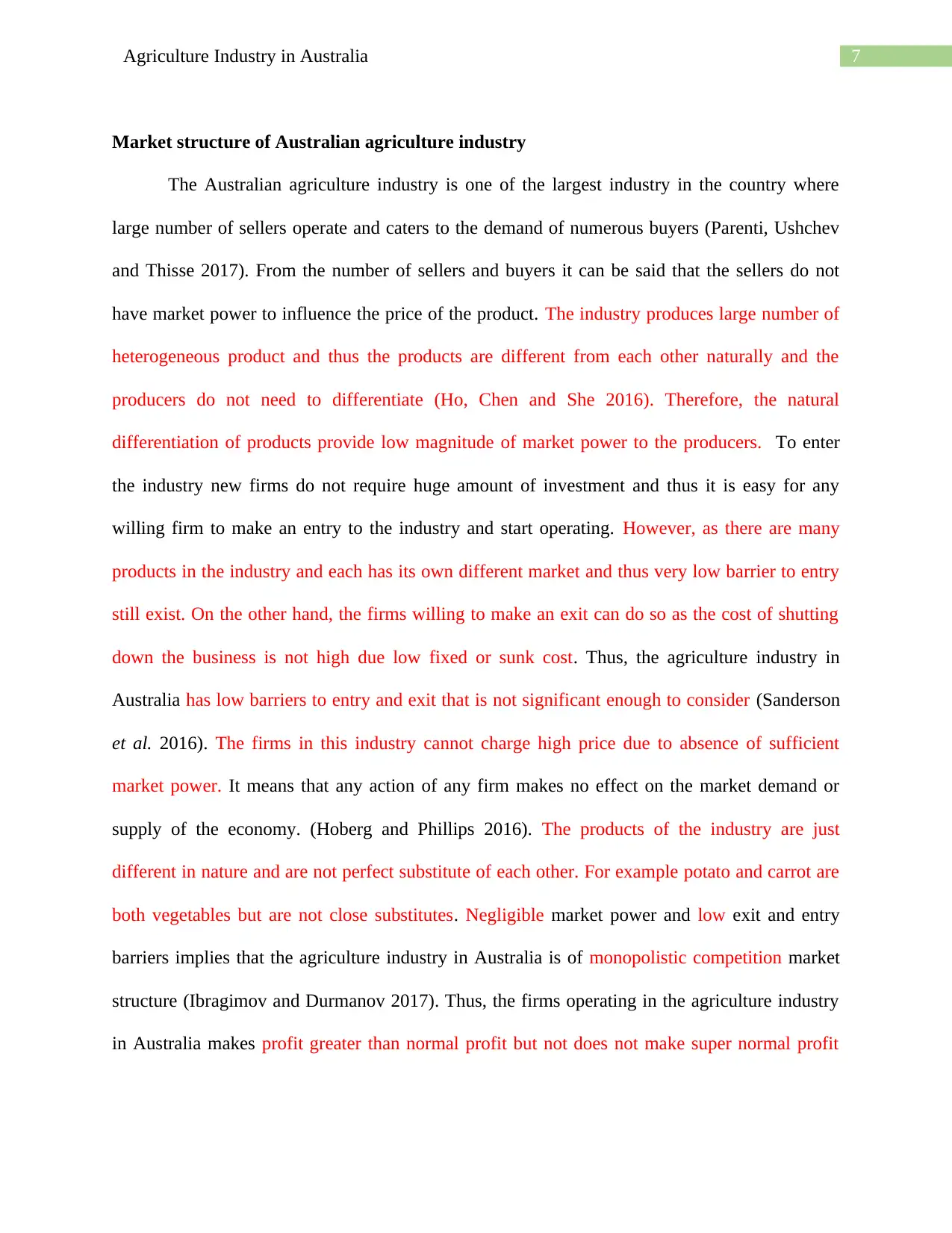
7Agriculture Industry in Australia
Market structure of Australian agriculture industry
The Australian agriculture industry is one of the largest industry in the country where
large number of sellers operate and caters to the demand of numerous buyers (Parenti, Ushchev
and Thisse 2017). From the number of sellers and buyers it can be said that the sellers do not
have market power to influence the price of the product. The industry produces large number of
heterogeneous product and thus the products are different from each other naturally and the
producers do not need to differentiate (Ho, Chen and She 2016). Therefore, the natural
differentiation of products provide low magnitude of market power to the producers. To enter
the industry new firms do not require huge amount of investment and thus it is easy for any
willing firm to make an entry to the industry and start operating. However, as there are many
products in the industry and each has its own different market and thus very low barrier to entry
still exist. On the other hand, the firms willing to make an exit can do so as the cost of shutting
down the business is not high due low fixed or sunk cost. Thus, the agriculture industry in
Australia has low barriers to entry and exit that is not significant enough to consider (Sanderson
et al. 2016). The firms in this industry cannot charge high price due to absence of sufficient
market power. It means that any action of any firm makes no effect on the market demand or
supply of the economy. (Hoberg and Phillips 2016). The products of the industry are just
different in nature and are not perfect substitute of each other. For example potato and carrot are
both vegetables but are not close substitutes. Negligible market power and low exit and entry
barriers implies that the agriculture industry in Australia is of monopolistic competition market
structure (Ibragimov and Durmanov 2017). Thus, the firms operating in the agriculture industry
in Australia makes profit greater than normal profit but not does not make super normal profit
Market structure of Australian agriculture industry
The Australian agriculture industry is one of the largest industry in the country where
large number of sellers operate and caters to the demand of numerous buyers (Parenti, Ushchev
and Thisse 2017). From the number of sellers and buyers it can be said that the sellers do not
have market power to influence the price of the product. The industry produces large number of
heterogeneous product and thus the products are different from each other naturally and the
producers do not need to differentiate (Ho, Chen and She 2016). Therefore, the natural
differentiation of products provide low magnitude of market power to the producers. To enter
the industry new firms do not require huge amount of investment and thus it is easy for any
willing firm to make an entry to the industry and start operating. However, as there are many
products in the industry and each has its own different market and thus very low barrier to entry
still exist. On the other hand, the firms willing to make an exit can do so as the cost of shutting
down the business is not high due low fixed or sunk cost. Thus, the agriculture industry in
Australia has low barriers to entry and exit that is not significant enough to consider (Sanderson
et al. 2016). The firms in this industry cannot charge high price due to absence of sufficient
market power. It means that any action of any firm makes no effect on the market demand or
supply of the economy. (Hoberg and Phillips 2016). The products of the industry are just
different in nature and are not perfect substitute of each other. For example potato and carrot are
both vegetables but are not close substitutes. Negligible market power and low exit and entry
barriers implies that the agriculture industry in Australia is of monopolistic competition market
structure (Ibragimov and Durmanov 2017). Thus, the firms operating in the agriculture industry
in Australia makes profit greater than normal profit but not does not make super normal profit
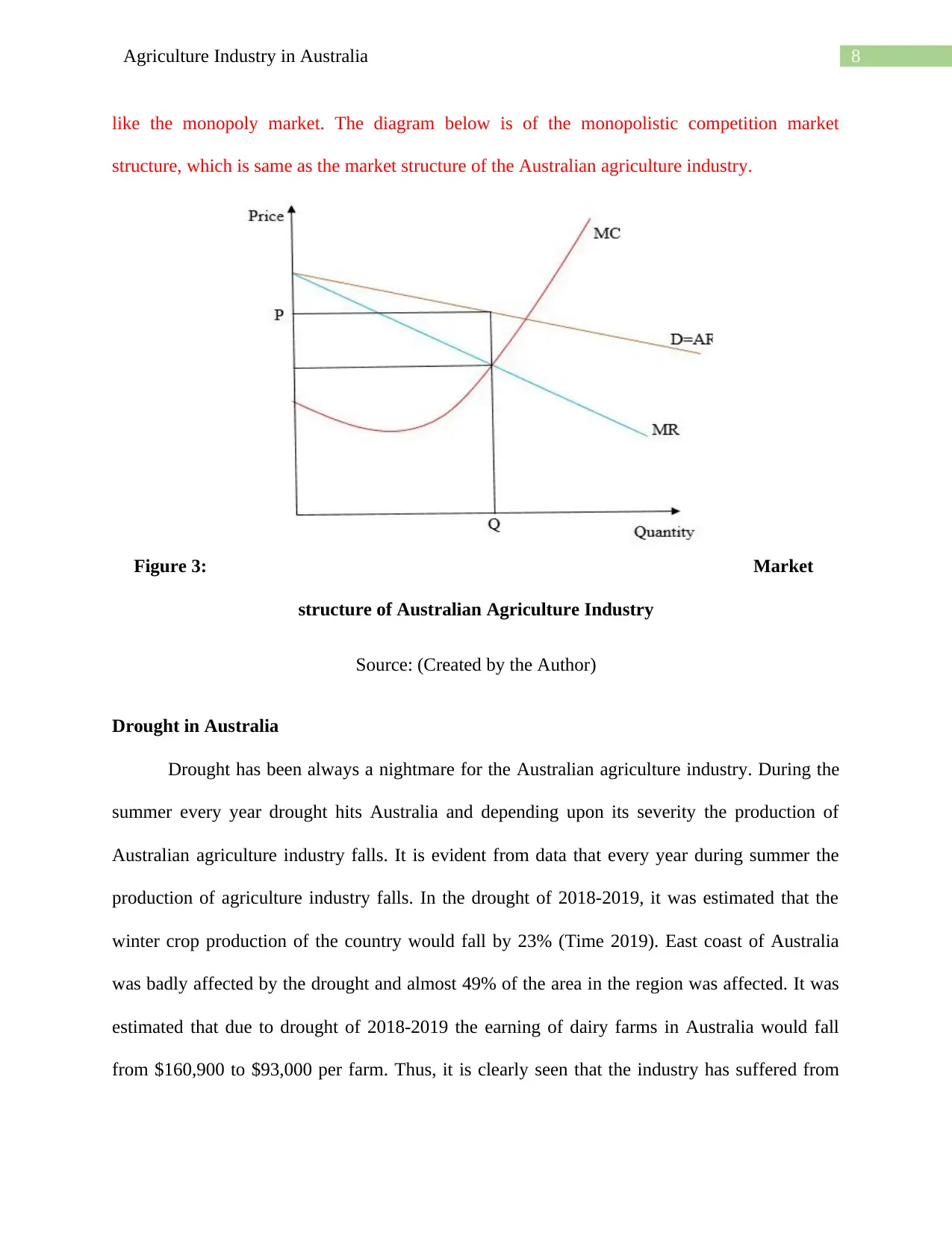
8Agriculture Industry in Australia
like the monopoly market. The diagram below is of the monopolistic competition market
structure, which is same as the market structure of the Australian agriculture industry.
Figure 3: Market
structure of Australian Agriculture Industry
Source: (Created by the Author)
Drought in Australia
Drought has been always a nightmare for the Australian agriculture industry. During the
summer every year drought hits Australia and depending upon its severity the production of
Australian agriculture industry falls. It is evident from data that every year during summer the
production of agriculture industry falls. In the drought of 2018-2019, it was estimated that the
winter crop production of the country would fall by 23% (Time 2019). East coast of Australia
was badly affected by the drought and almost 49% of the area in the region was affected. It was
estimated that due to drought of 2018-2019 the earning of dairy farms in Australia would fall
from $160,900 to $93,000 per farm. Thus, it is clearly seen that the industry has suffered from
like the monopoly market. The diagram below is of the monopolistic competition market
structure, which is same as the market structure of the Australian agriculture industry.
Figure 3: Market
structure of Australian Agriculture Industry
Source: (Created by the Author)
Drought in Australia
Drought has been always a nightmare for the Australian agriculture industry. During the
summer every year drought hits Australia and depending upon its severity the production of
Australian agriculture industry falls. It is evident from data that every year during summer the
production of agriculture industry falls. In the drought of 2018-2019, it was estimated that the
winter crop production of the country would fall by 23% (Time 2019). East coast of Australia
was badly affected by the drought and almost 49% of the area in the region was affected. It was
estimated that due to drought of 2018-2019 the earning of dairy farms in Australia would fall
from $160,900 to $93,000 per farm. Thus, it is clearly seen that the industry has suffered from
⊘ This is a preview!⊘
Do you want full access?
Subscribe today to unlock all pages.

Trusted by 1+ million students worldwide
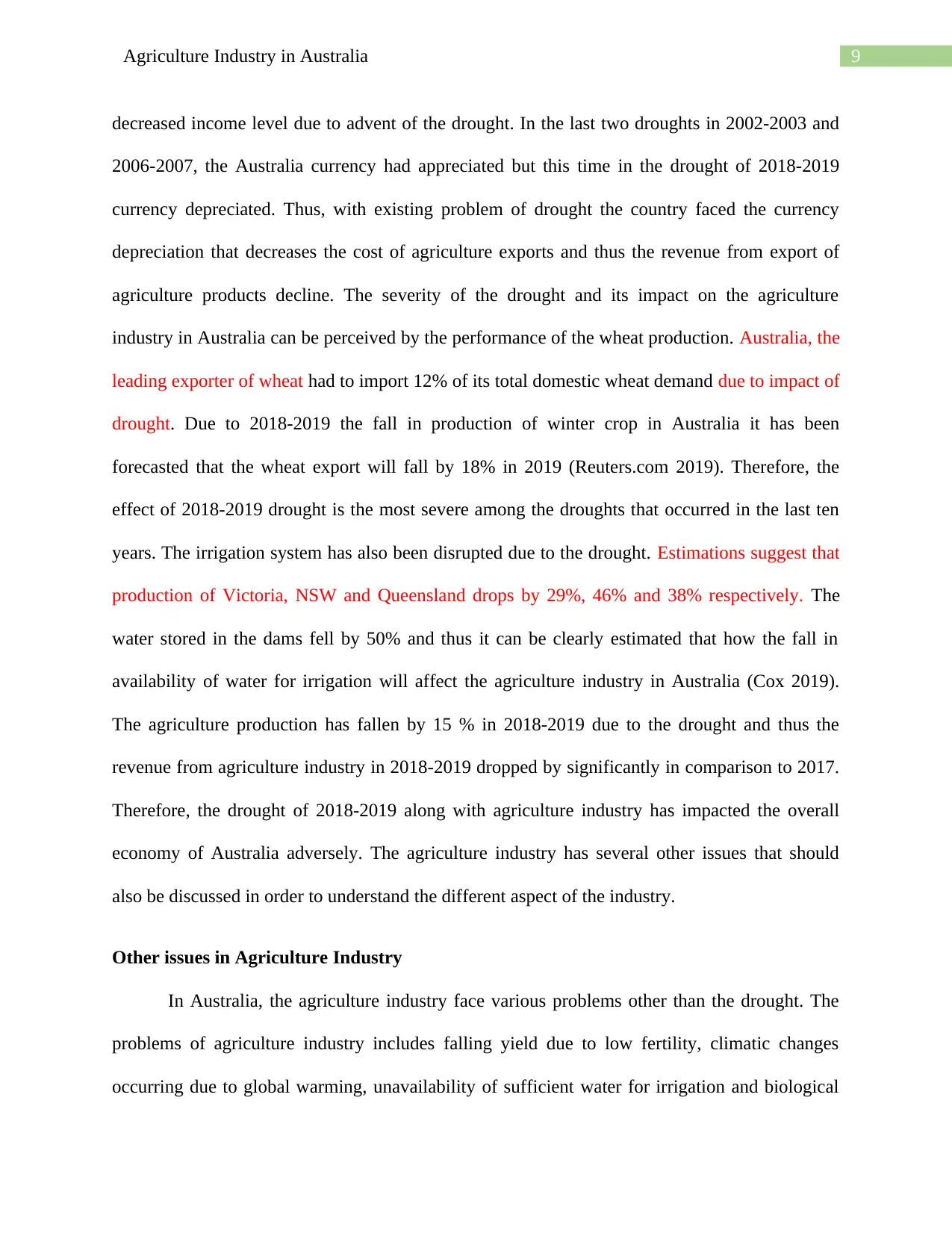
9Agriculture Industry in Australia
decreased income level due to advent of the drought. In the last two droughts in 2002-2003 and
2006-2007, the Australia currency had appreciated but this time in the drought of 2018-2019
currency depreciated. Thus, with existing problem of drought the country faced the currency
depreciation that decreases the cost of agriculture exports and thus the revenue from export of
agriculture products decline. The severity of the drought and its impact on the agriculture
industry in Australia can be perceived by the performance of the wheat production. Australia, the
leading exporter of wheat had to import 12% of its total domestic wheat demand due to impact of
drought. Due to 2018-2019 the fall in production of winter crop in Australia it has been
forecasted that the wheat export will fall by 18% in 2019 (Reuters.com 2019). Therefore, the
effect of 2018-2019 drought is the most severe among the droughts that occurred in the last ten
years. The irrigation system has also been disrupted due to the drought. Estimations suggest that
production of Victoria, NSW and Queensland drops by 29%, 46% and 38% respectively. The
water stored in the dams fell by 50% and thus it can be clearly estimated that how the fall in
availability of water for irrigation will affect the agriculture industry in Australia (Cox 2019).
The agriculture production has fallen by 15 % in 2018-2019 due to the drought and thus the
revenue from agriculture industry in 2018-2019 dropped by significantly in comparison to 2017.
Therefore, the drought of 2018-2019 along with agriculture industry has impacted the overall
economy of Australia adversely. The agriculture industry has several other issues that should
also be discussed in order to understand the different aspect of the industry.
Other issues in Agriculture Industry
In Australia, the agriculture industry face various problems other than the drought. The
problems of agriculture industry includes falling yield due to low fertility, climatic changes
occurring due to global warming, unavailability of sufficient water for irrigation and biological
decreased income level due to advent of the drought. In the last two droughts in 2002-2003 and
2006-2007, the Australia currency had appreciated but this time in the drought of 2018-2019
currency depreciated. Thus, with existing problem of drought the country faced the currency
depreciation that decreases the cost of agriculture exports and thus the revenue from export of
agriculture products decline. The severity of the drought and its impact on the agriculture
industry in Australia can be perceived by the performance of the wheat production. Australia, the
leading exporter of wheat had to import 12% of its total domestic wheat demand due to impact of
drought. Due to 2018-2019 the fall in production of winter crop in Australia it has been
forecasted that the wheat export will fall by 18% in 2019 (Reuters.com 2019). Therefore, the
effect of 2018-2019 drought is the most severe among the droughts that occurred in the last ten
years. The irrigation system has also been disrupted due to the drought. Estimations suggest that
production of Victoria, NSW and Queensland drops by 29%, 46% and 38% respectively. The
water stored in the dams fell by 50% and thus it can be clearly estimated that how the fall in
availability of water for irrigation will affect the agriculture industry in Australia (Cox 2019).
The agriculture production has fallen by 15 % in 2018-2019 due to the drought and thus the
revenue from agriculture industry in 2018-2019 dropped by significantly in comparison to 2017.
Therefore, the drought of 2018-2019 along with agriculture industry has impacted the overall
economy of Australia adversely. The agriculture industry has several other issues that should
also be discussed in order to understand the different aspect of the industry.
Other issues in Agriculture Industry
In Australia, the agriculture industry face various problems other than the drought. The
problems of agriculture industry includes falling yield due to low fertility, climatic changes
occurring due to global warming, unavailability of sufficient water for irrigation and biological
Paraphrase This Document
Need a fresh take? Get an instant paraphrase of this document with our AI Paraphraser
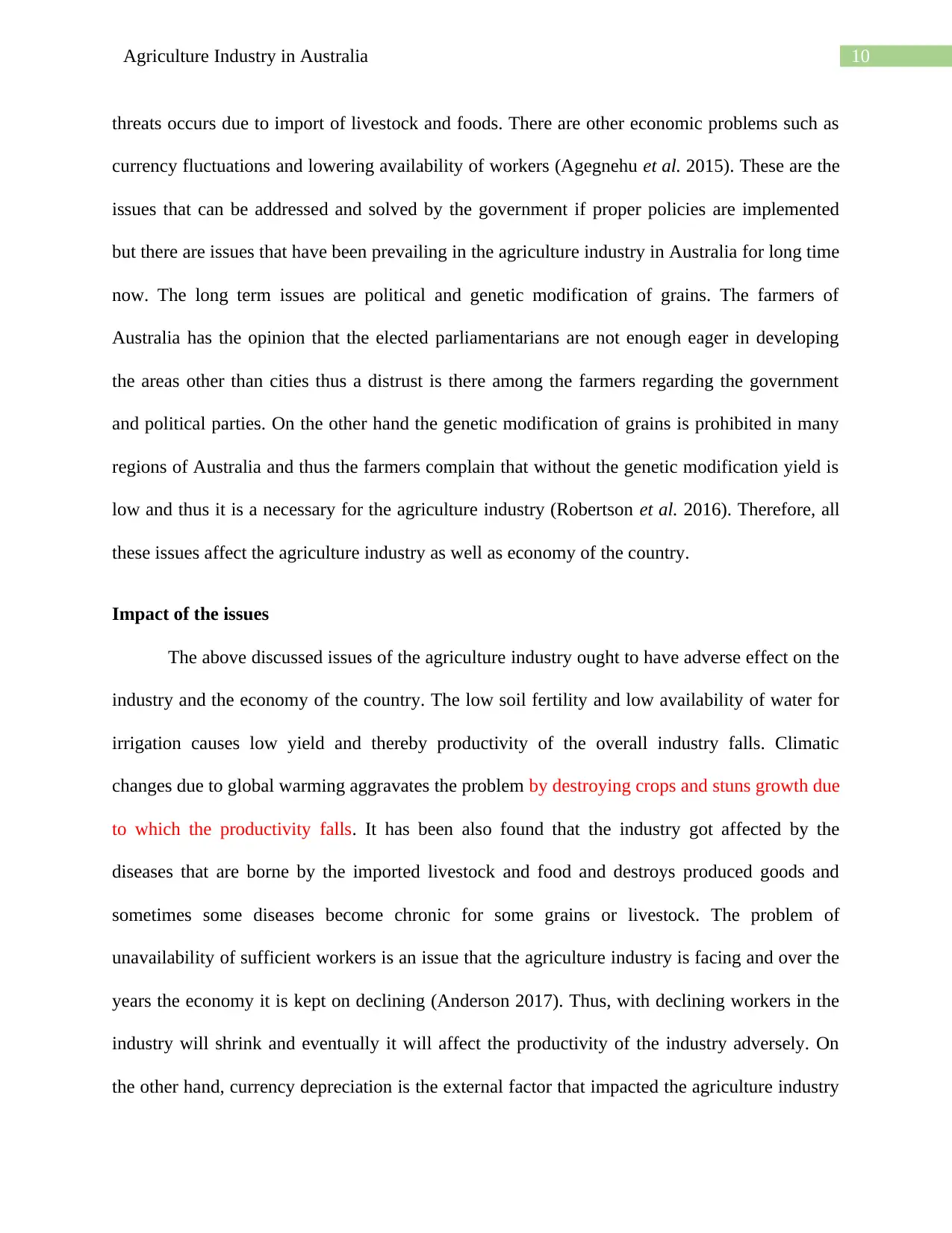
10Agriculture Industry in Australia
threats occurs due to import of livestock and foods. There are other economic problems such as
currency fluctuations and lowering availability of workers (Agegnehu et al. 2015). These are the
issues that can be addressed and solved by the government if proper policies are implemented
but there are issues that have been prevailing in the agriculture industry in Australia for long time
now. The long term issues are political and genetic modification of grains. The farmers of
Australia has the opinion that the elected parliamentarians are not enough eager in developing
the areas other than cities thus a distrust is there among the farmers regarding the government
and political parties. On the other hand the genetic modification of grains is prohibited in many
regions of Australia and thus the farmers complain that without the genetic modification yield is
low and thus it is a necessary for the agriculture industry (Robertson et al. 2016). Therefore, all
these issues affect the agriculture industry as well as economy of the country.
Impact of the issues
The above discussed issues of the agriculture industry ought to have adverse effect on the
industry and the economy of the country. The low soil fertility and low availability of water for
irrigation causes low yield and thereby productivity of the overall industry falls. Climatic
changes due to global warming aggravates the problem by destroying crops and stuns growth due
to which the productivity falls. It has been also found that the industry got affected by the
diseases that are borne by the imported livestock and food and destroys produced goods and
sometimes some diseases become chronic for some grains or livestock. The problem of
unavailability of sufficient workers is an issue that the agriculture industry is facing and over the
years the economy it is kept on declining (Anderson 2017). Thus, with declining workers in the
industry will shrink and eventually it will affect the productivity of the industry adversely. On
the other hand, currency depreciation is the external factor that impacted the agriculture industry
threats occurs due to import of livestock and foods. There are other economic problems such as
currency fluctuations and lowering availability of workers (Agegnehu et al. 2015). These are the
issues that can be addressed and solved by the government if proper policies are implemented
but there are issues that have been prevailing in the agriculture industry in Australia for long time
now. The long term issues are political and genetic modification of grains. The farmers of
Australia has the opinion that the elected parliamentarians are not enough eager in developing
the areas other than cities thus a distrust is there among the farmers regarding the government
and political parties. On the other hand the genetic modification of grains is prohibited in many
regions of Australia and thus the farmers complain that without the genetic modification yield is
low and thus it is a necessary for the agriculture industry (Robertson et al. 2016). Therefore, all
these issues affect the agriculture industry as well as economy of the country.
Impact of the issues
The above discussed issues of the agriculture industry ought to have adverse effect on the
industry and the economy of the country. The low soil fertility and low availability of water for
irrigation causes low yield and thereby productivity of the overall industry falls. Climatic
changes due to global warming aggravates the problem by destroying crops and stuns growth due
to which the productivity falls. It has been also found that the industry got affected by the
diseases that are borne by the imported livestock and food and destroys produced goods and
sometimes some diseases become chronic for some grains or livestock. The problem of
unavailability of sufficient workers is an issue that the agriculture industry is facing and over the
years the economy it is kept on declining (Anderson 2017). Thus, with declining workers in the
industry will shrink and eventually it will affect the productivity of the industry adversely. On
the other hand, currency depreciation is the external factor that impacted the agriculture industry
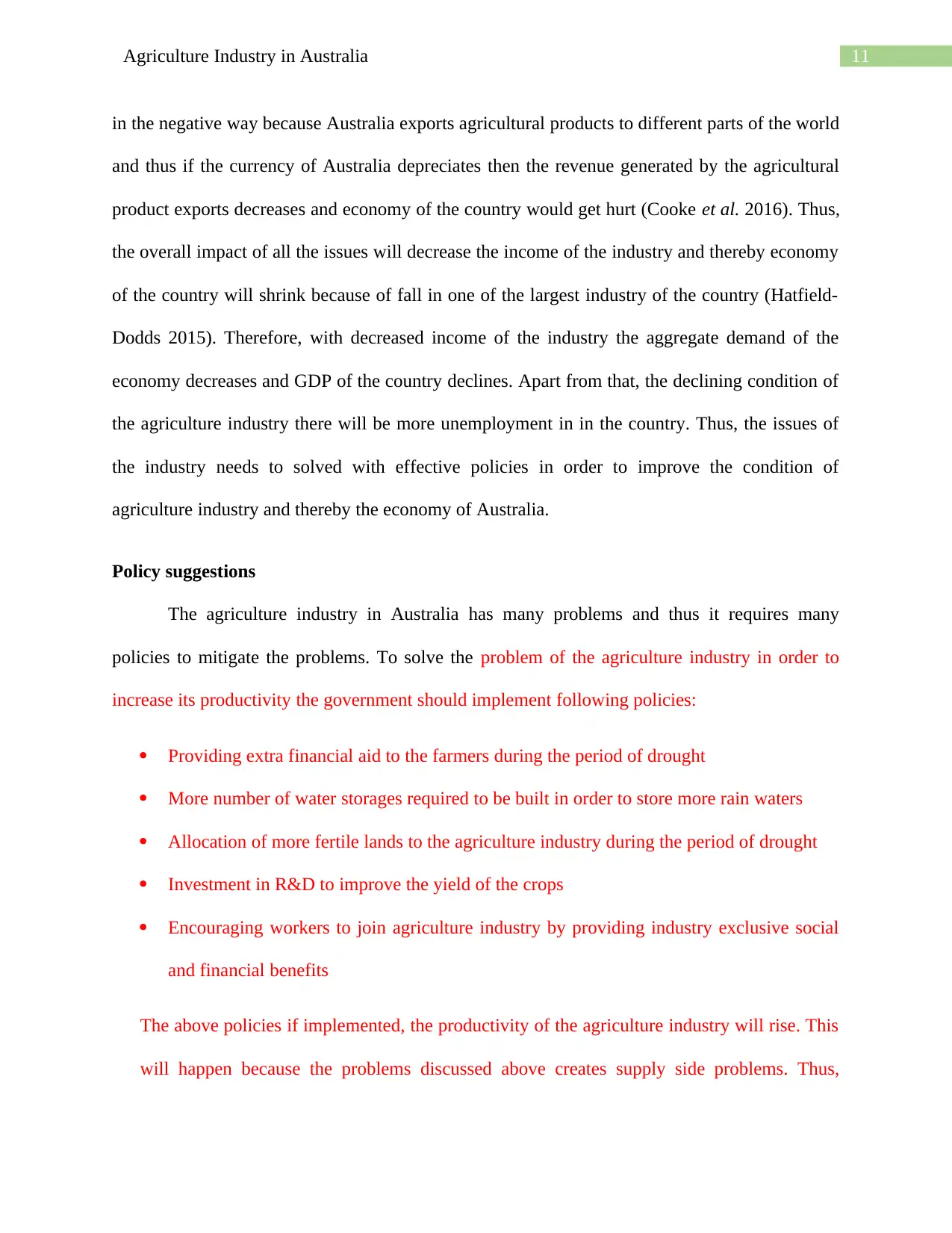
11Agriculture Industry in Australia
in the negative way because Australia exports agricultural products to different parts of the world
and thus if the currency of Australia depreciates then the revenue generated by the agricultural
product exports decreases and economy of the country would get hurt (Cooke et al. 2016). Thus,
the overall impact of all the issues will decrease the income of the industry and thereby economy
of the country will shrink because of fall in one of the largest industry of the country (Hatfield-
Dodds 2015). Therefore, with decreased income of the industry the aggregate demand of the
economy decreases and GDP of the country declines. Apart from that, the declining condition of
the agriculture industry there will be more unemployment in in the country. Thus, the issues of
the industry needs to solved with effective policies in order to improve the condition of
agriculture industry and thereby the economy of Australia.
Policy suggestions
The agriculture industry in Australia has many problems and thus it requires many
policies to mitigate the problems. To solve the problem of the agriculture industry in order to
increase its productivity the government should implement following policies:
Providing extra financial aid to the farmers during the period of drought
More number of water storages required to be built in order to store more rain waters
Allocation of more fertile lands to the agriculture industry during the period of drought
Investment in R&D to improve the yield of the crops
Encouraging workers to join agriculture industry by providing industry exclusive social
and financial benefits
The above policies if implemented, the productivity of the agriculture industry will rise. This
will happen because the problems discussed above creates supply side problems. Thus,
in the negative way because Australia exports agricultural products to different parts of the world
and thus if the currency of Australia depreciates then the revenue generated by the agricultural
product exports decreases and economy of the country would get hurt (Cooke et al. 2016). Thus,
the overall impact of all the issues will decrease the income of the industry and thereby economy
of the country will shrink because of fall in one of the largest industry of the country (Hatfield-
Dodds 2015). Therefore, with decreased income of the industry the aggregate demand of the
economy decreases and GDP of the country declines. Apart from that, the declining condition of
the agriculture industry there will be more unemployment in in the country. Thus, the issues of
the industry needs to solved with effective policies in order to improve the condition of
agriculture industry and thereby the economy of Australia.
Policy suggestions
The agriculture industry in Australia has many problems and thus it requires many
policies to mitigate the problems. To solve the problem of the agriculture industry in order to
increase its productivity the government should implement following policies:
Providing extra financial aid to the farmers during the period of drought
More number of water storages required to be built in order to store more rain waters
Allocation of more fertile lands to the agriculture industry during the period of drought
Investment in R&D to improve the yield of the crops
Encouraging workers to join agriculture industry by providing industry exclusive social
and financial benefits
The above policies if implemented, the productivity of the agriculture industry will rise. This
will happen because the problems discussed above creates supply side problems. Thus,
⊘ This is a preview!⊘
Do you want full access?
Subscribe today to unlock all pages.

Trusted by 1+ million students worldwide
1 out of 16
Related Documents
Your All-in-One AI-Powered Toolkit for Academic Success.
+13062052269
info@desklib.com
Available 24*7 on WhatsApp / Email
![[object Object]](/_next/static/media/star-bottom.7253800d.svg)
Unlock your academic potential
Copyright © 2020–2025 A2Z Services. All Rights Reserved. Developed and managed by ZUCOL.





